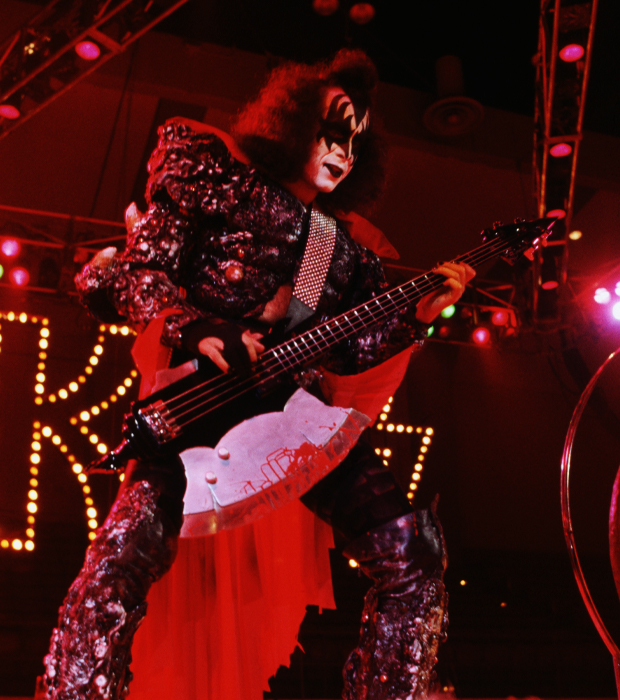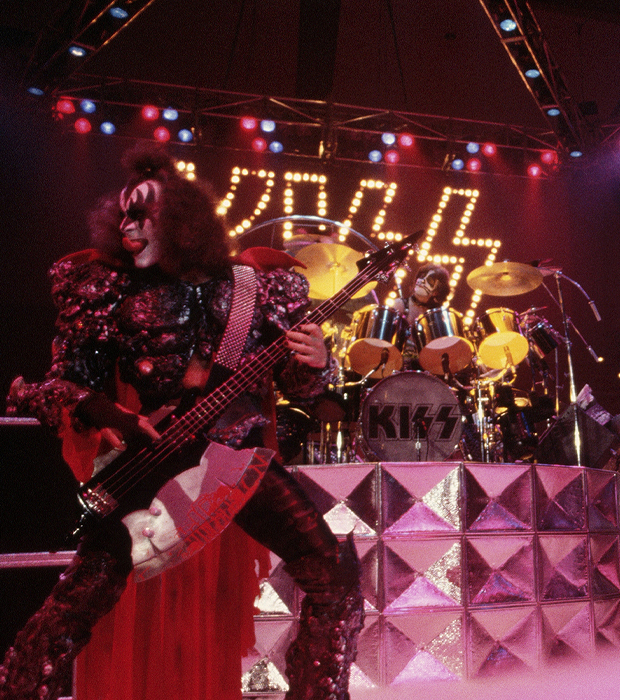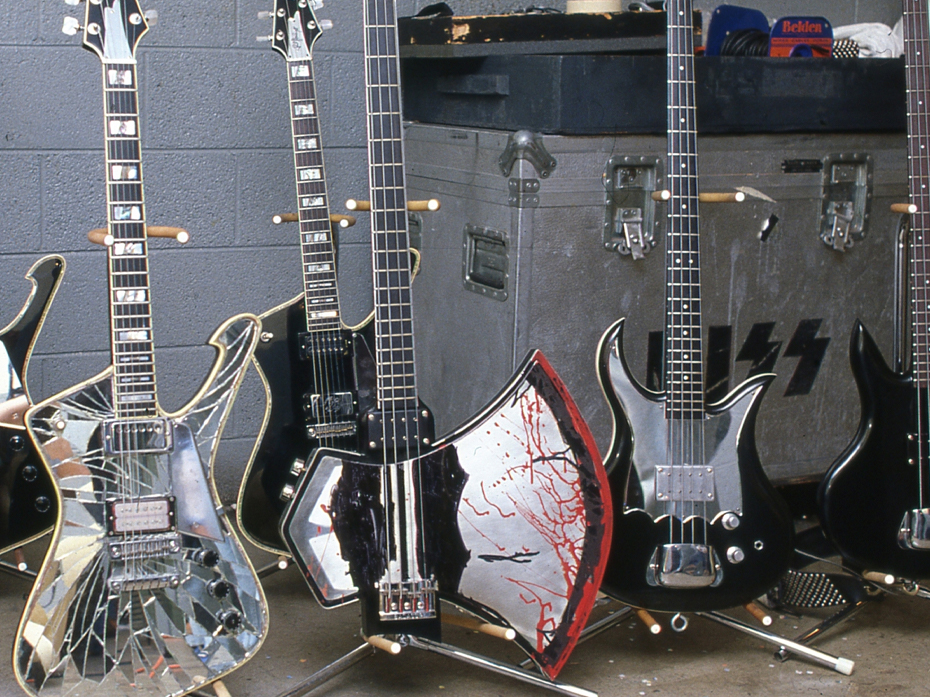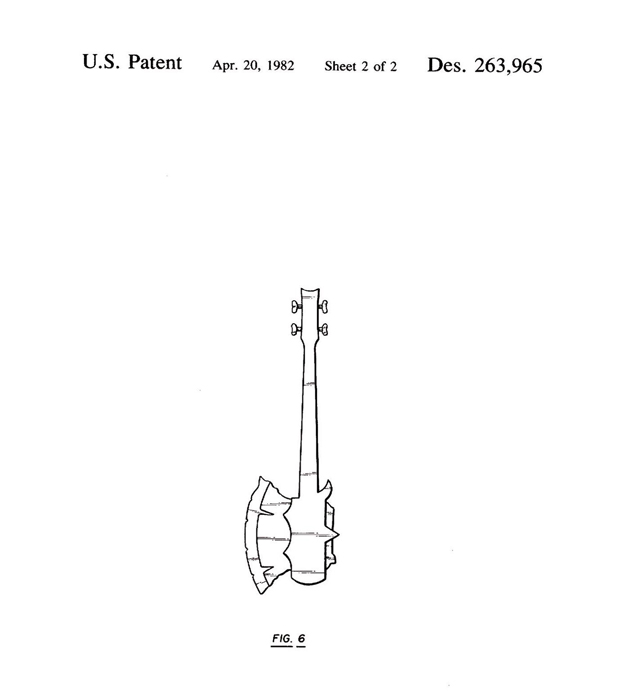
Lakeland, Florida June 14, 1979
Photographer unknown

Lakeland, Florida June 14, 1979
Photographer unknown

In recent years the story of the earliest basses has become even more muddled than it was before. In 1996 Gene claimed that "the original one was made by Valdez here in Los Angeles, and I still have it around here somewhere". (Metal Edge presents KISS Alive! 1996) In a 2013 video interview with Japanese music store G-Club he claimed that it has been built specifically for a photo shoot. Based on this I assumed that the first known photo shoot where Gene posed with an Axe bass—June 14 in Lakeland, Florida—featured the Valdez Axe bass.



However, in 2020 an auction appeared on Gotta Have Rock and Roll (LOT 33812) featuring this very bass. The auction description (partially) reads: "One of the earliest Axe Bass guitars ever used by Simmons, this guitar was created by famed guitar maker Steve Carr in 1978". The bass auctioned off came with a letter of authenticity from Carr but that is sadly not available in the auction details. What it does have is a good enough resemblance to the bass seen on June 14, 1979. Eagle-eyed readers will immediately spot that the knobs are different and that the "cracks" on the blade don't look the same. These cosmetic differences are explained by the auction noting that "the Axe was first painted black, then refinished to be silver, then repainted black before Gene gave it back to Steve Carr to put the guitar out of commission". Carr being tasked with putting the bass "out of commission" would also explain the difference in pickup. The bass sold in 2020 didn't have a DiMarzio Model One which the bass sported in 1979.

But the refinishing of the bass fits with what we can verify from photos from 1979. Less than a week after the initial photo shoot KISS found themselves in Savannah, Georgia to shoot promo videos for two of the songs from Dynasty. The better part of the blade, not just the edge, was now silver and the knobs had been changed so that they blended in with the color of the blade. (Reminder that we can almost always discern photo and/or video shoots from live performance when it comes to Gene. If he pretends to play fingerstyle it is with 100% certainty a photo/video shoot.)



Despite the new look this bass only made two more appearances. First in an undated photo shoot, the volcanoes photo below. We can really only say that this photo shoot happened after June 14 because of the color of the blade. And then this first Axe actually made it on stage once, but funnily enough it was not in the hands of Gene! The story differs a little based on who tells it but the basics are that on July 13 in Pontiac, Michigan Rick Nielsen of opening act Cheap Trick was hit by a frisbee thrown from the audience. Tom Petersen got the Axe bass and threatened whoever threw the frisbee with bodily harm.



Since this version of the Axe bass was cosmetically almost identical to the basses Gene would later play I think that it failed to catch on because of three things. First, the headstock. Gene has generally favored a two-a-side tuner arrangement but he prefers standard, outward-facing tuning pegs. Even if he rarely tuned his bass himself by this time the rear-facing tuning pegs probably weren't to his liking. Second, the protrusion at the end of the body. As seen above it could be held on to for posing but it was surely impractical. That one detail would exclude it from sitting securely in most standard guitar stands which would make the bass tech's work more cumbersome. Third, the placement of the pickup. The closer a pickup is to the neck the more the low end is accentuated and that wasn't Gene's tone. With this pickup placement it would be a tall order to get Gene's tone so he couldn't just strap on the Axe after having played the Spector. To have a reasonably similar tone a lot would have to be adjusted when moving from the Spector to the Axe and then back again. That kind of needless complexity was antithetical to the KISS live spectacle. Unfortunately Carr doesn't seem to have been very attuned to the wants of his client.
The problem with Carr claiming that the Axe bass above was built in 1978 is that he has claimed that the following Axe was the first. And he has claimed, in a signed letter of Official provenance and certification, that it was built in the spring of 1979 and that he delivered it to Gene in Detroit on July 13, 1979. One could wonder what the odds are that this Axe would be delivered the same day Petersen "used" the previous Axe on stage, but based on when we first get to see this second Axe in photo shoots it is at least plausible. Below are two photos from the Viewmaster sessions on July 31 or August 1, 1979.


If we go back to the three issues I postulated that Gene may have had with the first Axe bass, two of them were fixed with this version. The headstock—which was the first to feature an inlay of Gene's makeup—had two-a-side tuners with the tuning pegs facing outward. And as a plus detail the tuning pegs were small axes! But the pickup placement was still an issue and I feel confident in stating that this bass had two other problems.


Just look at the thickness of that body! The first Axe tapered off towards the edge of the blade like a proper axe would, but this one has the same thickness the entire way. And it looks about as thick as a Les Paul. This thing must weigh a ton. And the placement of the knobs... In the history of guitar and bass players, I doubt there are many performers less suited to having the knobs towards the body than Gene Simmons. The lava gargoyle suit would rub up against, and most likely change, the volume and/or tone as soon as Gene went into his first choreographed move. But the bass traveled with the band and although it never made it on stage we have the following backstage photo.

As the photo above shows Gene had used a black magic marker to indicate what he wanted changed. Essentially he wanted the look of the first Axe bass with some additional cracks. (There is a possibility that the knobs have been changed once we get to September. These are much more silvery than the black speed knobs that appear to be on the bass for the Viewmaster photos. The knobs on the bass when it was auctioned off were not original.)
Having apparently learned his lesson, Carr came back with a third try. This was identified as the third-built Carr Axe by Carr himself who signed it thus for on the back of the headstock before bequeathing it to one Terry Nix of Guitars of the Stars. (That signature isn't visible in the photos below though.) It was last auctioned by Gotta Have Rock and Roll in 2019 (LOT 27551) and it currently resides in the MoPop Museum of Pop Culture in Seattle, Washington (object number 2000.339.6). I've used the dating of the bass from that 2019 auction but it seems more likely that this bass was also built in 1979.

This bass is the original upon which pretty much all the later Axe basses were based. The blade/body is almost identical to the Kramer Axe and the later Jackson Axe, and, as seen below, it was the basis for the line drawings that accompanied one of Gene's patents for the Axe design. This is the reason why I think it was built in 1979. The patent application was submitted on February 29, 1980, and had to have been preceded by a lot of work in getting the specifications (and the legal bits) right.



When Gene partnered with Kramer to make the Axe a commercial venture he presented them with Carr Axe no. 3 to use as a blueprint. We can deduce this because there is a photo from the Sports Factory that show this Axe on one of the work benches. (Sport Factory in Connecticut produced bodies and necks for Kramer which were then assembled in the Kramer factory in Neptune, New Jersey.)
According to the 2000 Butterfields Auction (LOT 1564) this Axe bass was used during the 10th Anniversary Tour. This is just the KISS organization—and Gene in particular—not having enough information nor caring enough to get things right. There are at present no photos from that tour that feature this bass, Gene used one of the Kramer Axes throughout the tour. Since the maker of this bass wasn't identified in the Butterfields auction we can assume that Carr signed the back of the headstock between 2000 and his untimely death in 2006.
Lastly we come to a real mystery Axe, one that we know even less about. This Axe is only known from a single set of photos taken by Raeanne Rubenstein for People magazine in 1980. It looks a lot less like the previous basses and more like a children's toy axe. This photo shows Gene in the "KISS room" at his mother's house and we get to see a murderer's row of interesting instruments. (I mean, just look at that Kramer XL5 between the mystery Axe and the skull/batwing bass.) I assume that this Axe bass was also built by Steve Carr based on the shape of the headstock and the look of the extended part behind the bridge which looks exactly the same as on Carr Axe no. 2.

It's harder to see in the photo above but the mystery Axe also appear to have axe head tuning pegs. This bass is the obvious template for the second patent Gene applied for on February 29, 1980. In a 2004 interview with John Tate of AceFrehleyLesPaul.com Carr said that "I made several of these until we hit a design that is pretty much what [Gene] uses today". Since this version has such a different look it feels as if it could be one of the prototypes Carr built but we really don't know.


